More and more armies of the world become owners of large-caliber MLRS
Large-caliber firstborn.
It is noteworthy that Japan was the first to enter the privileged club of the developing countries and owners of their own large-caliber multiple launch rocket systems, but at the same time it had to agree with some rules and reservations. In 1968, Japan armed its own Self-Defense Forces with an 307 Type 67 mm millimeter complex. In theory, this complex fell under the definition of the MLRS. It included combat vehicles with a launcher, which was installed on the chassis of the car “HINO”, which could reach speeds of up to 78 km / h. The fighting machine had two guides for firing missiles "Type 68". Their length was 4,5 meter, and the mass reached 573 kg. The Japanese large-caliber RSZO was launched at the rocket-space division of Nissan Motor Co. and the firing range of such installations reached 28 kilometers. To date, this large-caliber multiple launch rocket system has already been removed from production, since The Japanese military now prefers to purchase weapons of the MLRS type from their American partners. The Japanese "Type 67" was considered to be the MLRS, but in today's understanding of BM for two missiles - this is not the MLRS.
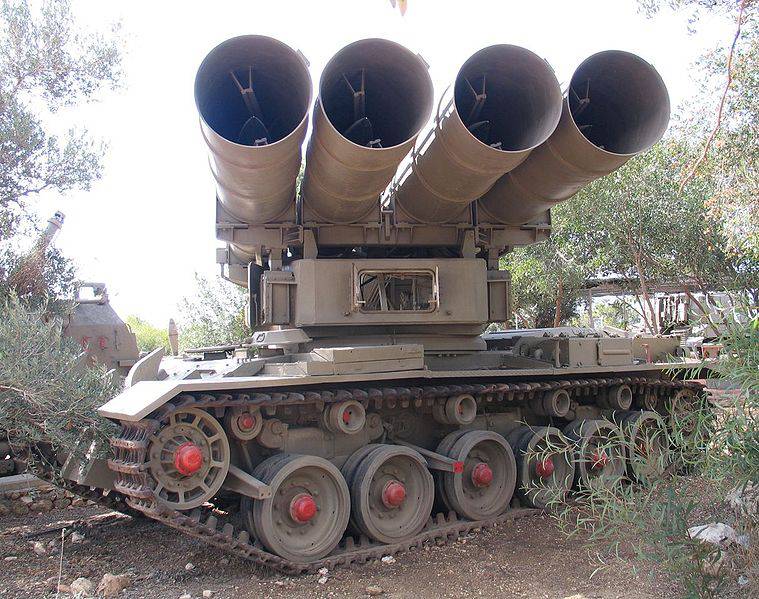
MAR-290 on the Centurion chassis for 290 caliber mm
The next country, which has always tried to develop various types of military-technical missions by itself, is Israel. This country has managed to apply the experience accumulated over many years to create MLRS. The state-owned IMI company in 1965 began work on a 290-millimeter multiple launch rocket system type MAR-290. This system was adopted by the national armed forces in the late 1960s. To date, the MAR-290 still serves the defense of Israel, according to some estimates, the country has 20 units of this equipment. After creation, this system has undergone a number of modifications. The first changes were that the MLRS of this type were put on the chassis tank "Sherman." The operating experience was not entirely successful, so the developers decided to put the MAR-290 on the chassis belonging to the main battle tank of Britain - Centurion. PU consists of four 6-meter guide pipes. A complete salvo installation takes 10 seconds. The mass of the combat vehicle is 50 tons, and the reserve going with 204 kilometers, the combat crew is 4 people. The firing range of 600-kilogram RS from 5,45 meters to 25 kilometers. Mass warhead RS is 320 kilograms. This missile system is characterized by guidance angles of the block of guides in elevation from 0 (+ -) to 60 (+ -), in azimuth of 360 (+ -). Recharge PU lasts about 10 minutes.
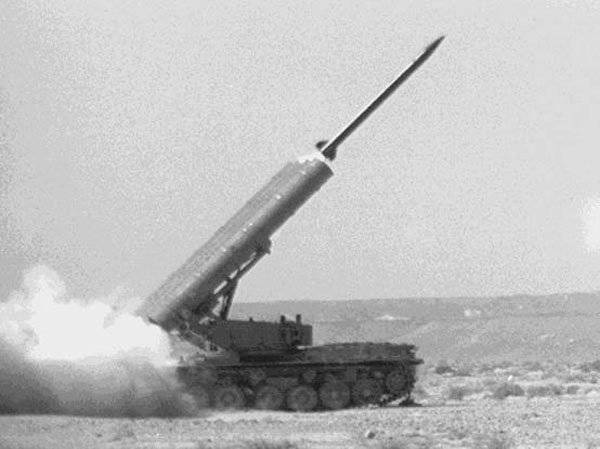
MAR-350
To date, foreign media specializing in military topics have reported that they are developing an improved type of MLRS. It has already been assigned the designation MAR-350, the caliber of this installation is equal to 350 millimeters. According to official data, the characteristics of this system will be as follows: from the guides, two two-rocket blocks are selected, each having an curb weight of 2 thousand kilograms, the block will have 6,2-meter length and 0,97-meter width; the height will be 0,45 meters, and the duration of a volley of four missiles of the order of 30 seconds.
Great-grandson "Katyusha".
The very first and the present large-caliber MLRS was the 300-milliliter MLRS released in the USSR under the name “Smerch”. It was developed by an association led by the Tula State Research and Production Enterprise Splav. It happened at the start of the 1980s.
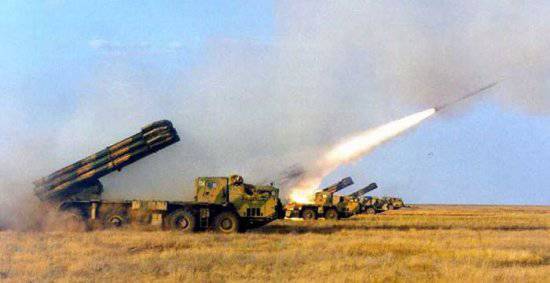
300-mm MLRS "Smerch"
By creating the Smerch, its development team was able to unswervingly prove in practice that increasing the effective range of the MLRS is possible. This rocket artillery could effectively shoot at 70, and even 90 kilometers. The creation of Tornado was a shocking shock to the West. American experts, conducting long-term research and development created the MLRS MLRS, the effective range of which was 30-40 kilometers. At the same time, American scientists were absolutely sure that this firing range is maximum for any MLRS. It was believed that a further increase in firing range would lead to too much dispersion of projectiles, which is unacceptable. How did our specialists solve this problem? They managed to create shells with a unique design. What was unique about them? They had an independent system for correcting the flight trajectory in pitch and yaw. It was this that ensured the accuracy of the hit, which was two or even three times higher than the figures of foreign MLRS. According to some calculations, this figure was no more than 0,21% of the launch range. Accuracy of shooting Soviet specialists managed to increase three times. Correction of the flight path of the rocket was carried out by gas-dynamic rudders. They worked from high-pressure gas, which came from an onboard gas generator. There was also a stabilization of the projectile in flight. It was achieved due to its rotation in flight around the longitudinal axis. The rotation itself was provided by the preliminary promotion of the rocket even when it was moving along a tubular guide; in flight, it was maintained due to the fact that the blades of the drop-down stabilizer were installed, which opened at an angle to the longitudinal axis of the projectile.
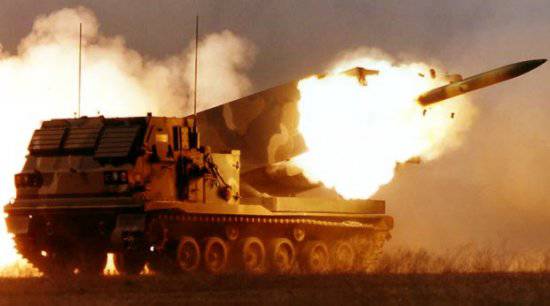
MLRS MLRS
But these are not all the outstanding features of the Smerch MLRS. The next peculiarity is that a whole arsenal of ammunition was developed for the “tornado”, the firing range of which reached 70 kilometers. These were missiles of the 9М55 family. The firing range was also achieved in 90 kilometers using rocket projectiles of the 9М52 and 9М53 families. They were equipped with completely different types of warheads. These included: cassette, which had fragmentation type combat elements; cassette with penetrating fragmentation combat elements; monoblock high-explosive fragmentation; cassette with fragmentation combat elements of contactless blasting; cluster with cumulative fragmentation combat elements; high-explosive, which was the head of the penetrating type; cassette with anti-tank or anti-personnel; thermobaric head; cluster, with standard self-targeting or small-sized self-targeting combat elements, as well as cluster with anti-personnel or even anti-tank mines.
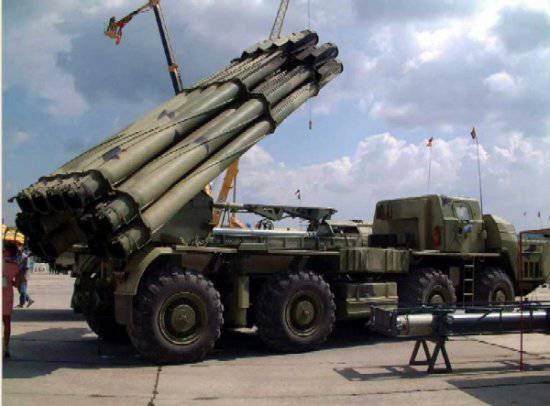
MLRS 9А52-2
To date, the Russian army is using an improved type of multiple launch rocket system 9А52-2. A number of foreign countries also use this jet system as a weapon. For example, countries such as Ukraine using 94 MLRS, Belarus with 40 copies, in Peru in using 10 systems, Algeria has 18, and Kuwait using 27 installations. It is worth noting that it was with Kuwait that the first contract for the export of MLRS Smerch was drawn up and implemented: in 1995, Russia granted 9 jet systems to the possession of Kuwait, and later, in 1996, more 18. Also in 1996, the export contract was drawn up with the UAE, according to which they were given six PU nine A52-2, an automated combat control system "Vivarium" and six TZM 9Е234-2.
One of the last countries to acquire Smerch was India. In 2003, a preliminary application was signed for the supply of 36-ti Smerch-M combat vehicles delivered to the Tatra chassis. The cost of the transaction was about 450-ti million dollars. Due to some events, the signing of the contract was postponed and only 31 December 2005 took place. In accordance with the contract, India received 28 9-52-2T combat vehicles mounted on the Tatra Т816 chassis. Some data says that 38 combat vehicles were still sold. The cost of the transaction amounted to about 500 million dollars. In May, the first batch of the order was sent to 2007 of the year, and in July of the same year, India signed an agreement for 24 combat vehicles, the cost of which was 600 million dollars. Another deal was concluded with Turkmenistan in June 2007. The order for this was for 6 complexes and the cost was indicated in 70 million dollars.
An extraordinarily interesting situation has arisen with respect to China: according to official data, the Smerch multiple rocket launcher system has never been delivered to the territory of this country, but today Chinese enterprises of the military-industrial complex have created two copies of the Smerch system. This country managed to copy systems of types A-100 and PHL-03 to a greater or lesser extent. As it turned out, China managed to make an exact copy of the PHL-03, and hence the question arose about whether the Chinese specialists had the Russian version of Smerch, because there are huge doubts that such an exact copy can be the result of studying photographic materials and video materials, various visual observations. Experts adhere to the version that if Russia did not really sell the MLRS data, then most likely, China secretly acquired such a system in the countries of the former Soviet republics. Such suppliers could well become Belarus or Ukraine.
Tornado is the son of Smerch.
After Smerch was adopted, the Tula State Research and Production Enterprise “rafting” developed a modernized version: 9K52-2. It differed from its predecessor in a reduced combat crew (it was reduced from 4-ex to 3-ex) and enhanced, improved automation of combat processes. 9А52-2Т, which was provided for export, went to the Tatra T816 chassis (10 * 10). There was another modification of "Tornado". The new "Smerch" appeared recently. This version is lightweight as well as a six-bar. The system is mounted on a four-wheel-drive all-wheel drive chassis, namely the KAMAZ-6350. To date, there are two sub-variants of such a combat vehicle: with a conventional tubular type 9YA295 type PU, and also with a PU with a removable container MH-196. The latter allegedly possesses a disposable container that is reloaded only at the manufacturer. Already the new complex was created within the framework of the concept that was used to create the American rocket launcher HIMARS. HIMARS is a small-sized analogue of the 227-millimeter and mixed complex jet propulsion systems OTR ATACMS. Also, the new complex was equipped with a modern fire control system, which allows you to distribute the battery on the ground and repeatedly increase its performance under conditions of targeted opposition from the enemy. In this system, computers are installed that process information without a person participating in this process. Tests passed another combat vehicle from the Smerch family, which was installed on the MAZ chassis. This system has a PU with two removable containers designed for six missiles each. Sometimes this combat vehicle is called the "Tornado."
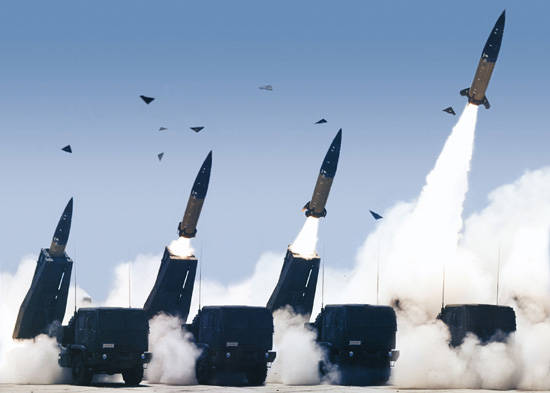
MLRS HIMARS
The development of the Smerch multiple launch rocket system continues unabated. Improving the combat vehicle is in the interests of the Defense Ministry of the Russian Federation. The modification takes place in the direction of equipping the PC with control systems with SNS receivers. Also discusses options for increasing the firing range.
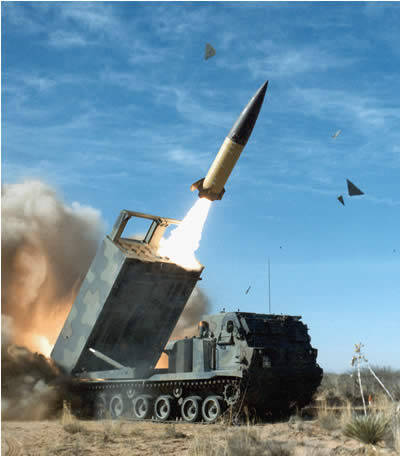
MLRS / OTP ATACMS
It is trying to increase the power of ammunition and expand their range. The new system, which the State Research and Production Enterprise Splav is working on, has the name Tornado-S. This jet system did not change the caliber of its predecessor, it remained millimeter 300. Research Institute "Search" is developing a guidance system for missiles "Tornado-S".
Exotic or variations on the theme.
There is no doubt that progress never stands still. Each country seeks to have at its disposal samples of weapons, military and special equipment such as long-range large-caliber MLRS. In general, today there is a clear trend towards an increase in the number of countries using large-caliber MLRS. But this is not the only trend; there is also a noticeable increase in the number of states whose military-industrial complex is capable of developing and setting up production of such systems on their own, sometimes using the method called “unlicensed copying”.
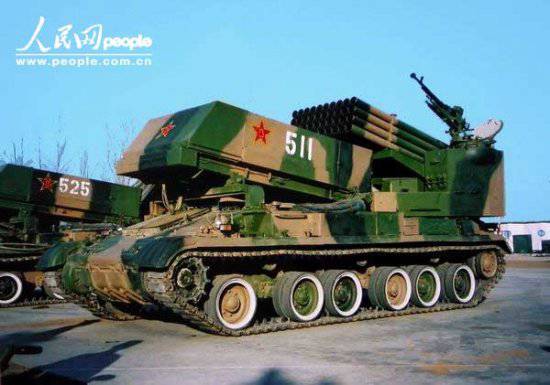
Chinese MLRS AP-1
The greatest interest at the moment are Brazilian and Iranian developments. Regarding the first one, it can be said that already in 1983, deliveries of ASTOS II multiple launch rocket systems to some units of the Brazilian army began. The name of the system stands for Artillery SaTuration Rocket System. This system was developed and produced by one of the local companies, namely, Avibras Aerospatial SA. It is worth noting that during the work on her missile, Brazilian developers have implemented a number of categorically new technical solutions. And it is precisely this that distinguishes this jet system from others having a similar class. By this very "ASTOS II" attracts a number of countries, and therefore this system is already available not only in Brazil, but also in Iraq, Saudi Arabia. ASTOS II MLRS was used in Operation 1991 of the Year - Desert Storm. The Brazilian military also tested their jet system in combat.
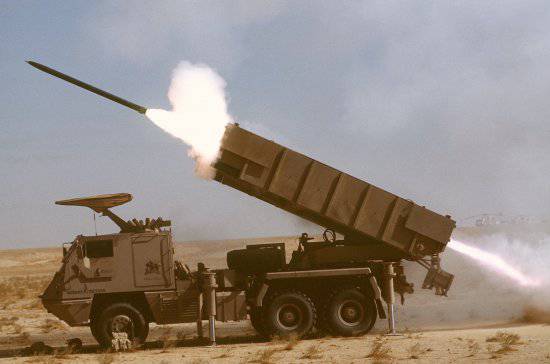
ASTOS - from Artillery SaTuration Rocket System
One of the most important distinguishing features of the ASTOS II MLRS is the ability to use it with a single universal AV-LMU PC type of several calibers at once. This naturally affected the ammunition installation. Its variations are: either it is a block of thirty-two rounds, having the type SS-30 and a caliber 127 of millimeters and a firing range of nine to thirty kilometers; The length is 3,9 meter, and the mass is 68 kilogram. Or the second option: a block of sixteen shells, type SS-40, caliber 180 millimeters and firing range from 15 to 35 kilometers. This configuration has a length of 4,2 meter and a lot of kilogram 152. The third configuration option is a block on the 4 projectile of the SS-80 type, which has a firing range reaching 90 kilometers, this is the most striking warhead. The artillery part of the launcher was made in accordance with the modular scheme. In general, this is a box-shaped farm, in which you can install up to four interchangeable TLCs, which have packages of guide tubes. In this case, the exact amount of TPK depends on the caliber of missiles. The replacement time of one TPK varies from 5-ti to 6-ti minutes. On the basis of the divisions of the ASTOS II MLRS, you can form shock groups of completely different military units.
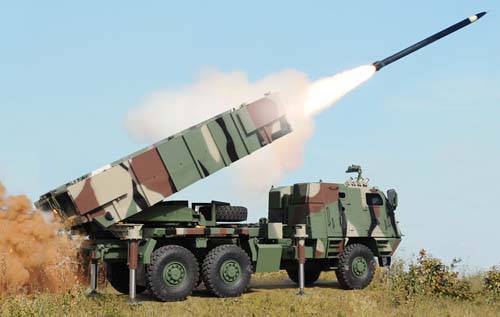
MLRS "Astros III"
Not so long ago, Brazilian developers even made an option for the ASTOS II MLRS, which provides for the use of a tactical missile, the launch range of which reaches 150 kilometers. The specific type of missile was not specified, but it is known that it can be equipped with a completely different type of warhead. The rockets used before were capable of the same, for them, in addition to the usual monoblock, also cluster warheads. There are three types of them: cluster, with cumulative fragmentation combat elements (KOBE; the basic part of the SS-40 type missile is 20 KOBE, the basic part of the SS-60 type missile is 65 KOBE), high-explosive fragmentation and cassette with anti-tank anti-tank weapons, and anti-tank anti-tank missiles with anti-tank missiles. . For the decommissioning of airfield runways air bases, missile warheads can be placed on a missile projectile. They are able to penetrate the ground to a depth of half a meter, which will reliably disable the runway. This effect is achieved by delaying the explosion.
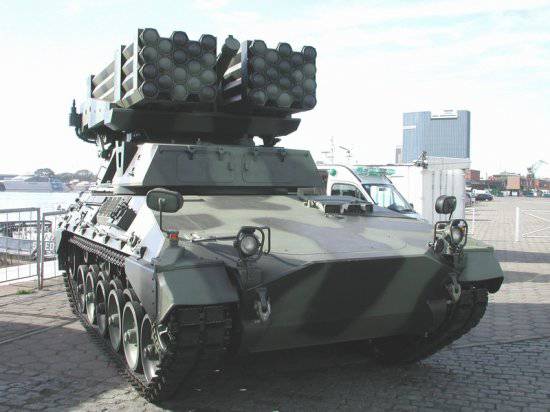
Vehiculo de Combate Lanza Cohetes
But this is not limited to the features of the MLRS, which can enhance its potential. Another one is that it can be used in the shells of the flight control system. This is possible due to the fact that the movement of the missile is adjusted for pitch and yaw. This scheme is similar to the one used in the Russian Smerche, which means it increases the accuracy of shooting. But here the correction of the flight path along the pitch and yaw angles occurs according to the control system signals. This is achieved with the help of gas-dynamic control surfaces. Their actuators begin to act on high-pressure gas from an onboard gas generator. The composition of the MLRS includes an automated control system for guidance and fire. Absolutely all the cars «ASTOS II» are placed on a three-axle chassis with high maneuverability (6 * 6). Their payload reaches 10-ti, and the speed can develop up to 90 km / h. Combat calculation BM is 4-e people.
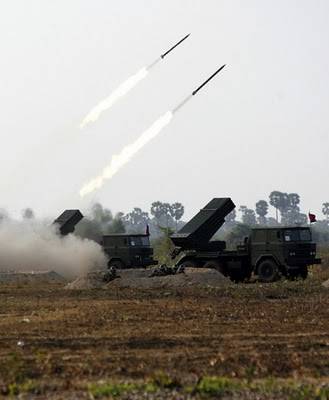
122 mm MLRS Type 83 (Chinese "clone")
On the basis of ASTOS II, using its own BM, a modified ASTOS III MRL was created. It uses PU blocks with existing shells. They include X-NUMX SS-60 type shells, which are up to 12 kilometers, SS-60 type shells, also 80, but up to 12 kilometers, the new SS-90. The firing range for which up to 150 kilometers. The latter have no caliber, but only two projectiles fit in each PU block, so it can be concluded that these are not missiles, but tactical or operational tactical missiles.
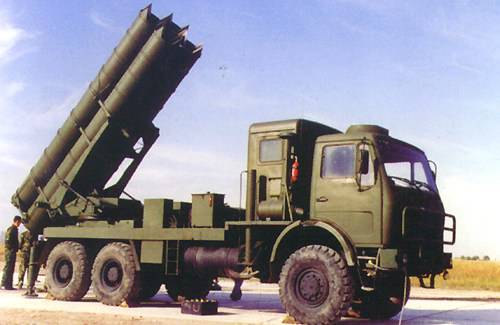
320-mm MLRS WS-1B
Argentina, with the assistance of Israel, developed a multi-caliber MLRS belonging to the VCLC family. VCLC - videoulo de Combate Lanza Cohetes. This was followed by the development of a XM millimeter version of the LAR-160. On its BM, which is placed on the chassis of a light TAM tank, thanks to which speeds of up to 160 km / h can be developed and there is a cruising range of 75 kilometers, 560 TPK is placed. Each of them has 2 shells. Their characteristic: the mass is equal to 18 kilograms, the mass of the warhead - 100 kilogram, the range reaches up to 46 kilometers. This system was tested in 30 year, after which it was decided to give it only for trial operation. And already in service, it was not adopted. There is a second option - this is VCLC-CAM. VCLC stands for Cohete de Artilleria Mediano. This option was developed for the Israeli 1986-millimeter projectile MAR-350. Characteristics are as follows: PU on four missiles, the mass of the RS is equal to 350 kilograms, and the effective range from 1000 to 75 kilometers. But work on this version was discontinued after only one prototype was created in 95.
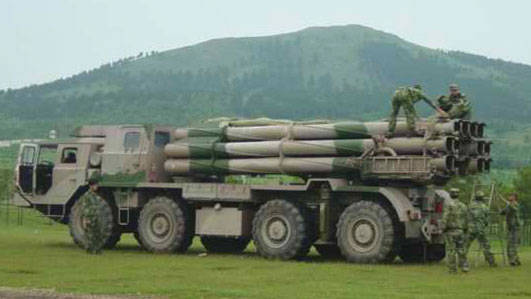
MLRS PHL-03
Iran, at the cost of incredible efforts, was also able to get its own volley fire system. This is a 320-millimeter MRL “Ogkhab”, which is translated as “Eagle”. This MRLS was developed by Teheran «DIO». It is worth noting that there has not been without the intervention of China. PU has three tubular guides, it is mounted on the chassis of the Mercedes-Benz LA911B (4 * 4). The mass of the PC is equal to 360-kilograms, the mass of high-explosive fragmentation warhead reaches 70 kilogram, the length is equal to 8,82 meters, and the firing range is approximately equal to 45 kilometers.
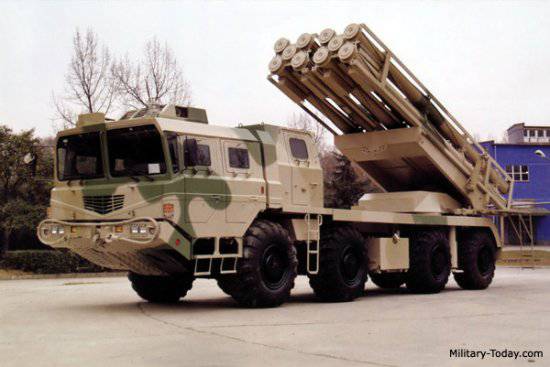
MLRS AR3
In 1986, the first shooting was carried out. It is alleged that it was live firing and took place near the city of Basra (Iraq). In 1988, the system was more actively applied in the “War of the Cities”. Then about 330 shells were fired at the top ten cities in Iraq. At the end of 1987, the serial production of this MLRS began. According to known data, this release was partially made at the expense of the capacities of Chinese enterprises. They are actively trying to sell the system abroad, but so far there has not been much success in this matter, because today there are already more efficient systems of this class. The Western press, along with the military, like to spread "horror stories" about the possibility of using missiles from the launcher of this MRL, which can be equipped with chemical warheads. This option can certainly not be excluded, especially if we consider that during the Iran-Iraq war, both countries were actively working on the creation of chemical weapons. And it is worth noting that the MLRS is the most effective means of delivering chemical warheads in combat.
Chinese "colleagues".
Farther than all countries in the field of creating their own large-caliber long-range jet systems of salvo fire could go China. Over the past thirty years, about half a dozen of such systems have been created there. At first, China tried to create remote-mining systems for the area, with the result that 284-mm “Type 74” and 305-glass “Type 79” came out from Chinese enterprises. They have a PU, the first on 10, the second on nine PCs. Their combat units have 10 anti-tank mines: "Type 69" or "Type 70" in plastic shells. To date, the People’s Liberation Army of China has 300-millimeter "Type 03" and 320-symmetrical reactive systems of salvo fire WS-1B.
The very first of these systems was developed by the Chinese company NORINCO. Truly, she is a copy of Russian Smerch, with the exception of some elements. The similarity is noticeable to the naked eye, because systems even outwardly virtually indistinguishable. The most notable exception is that the MLRS consist of Chinese CRMs developed and manufactured. Also present are transport-launch installations for reconnaissance and target designation - the UAV. BM is a PU with a package of twelve tubular guides. She put it on the chassis with increased maneuverability from the car TAS5380 (8 * 8). This machine is a Chinese copy of MAZ-543M. According to some, the supply of these cars was engaged in Belarus. The crew’s payload is equal to 4 people, the firing range varies from 20 to 150 kilometers. Since 2005, this system is in service. It is agreed that this year the MLRS of this type received an artillery brigade of the 54 Army Group, which is located in the Jinan Military District. She became the fourth brigade to receive PHL-03 multiple-launch rocket systems. Prior to this, these systems were delivered to the 1 Artillery Division of the 42 Army Group, the 9 Artillery Division of the 1 Army Group, and the 31 Army Group Brigade in Nanjing Military District.
MLRS 320-mm WS-1B was developed and actively produced under the direction of China Precision Machinery Import and Export Corporation. Its structure includes BM HF-4, mounted on the chassis of Mercedes-Benz, which have a high maneuverability - 2028A (6 * 6), their carrying capacity reaches 10 tons. They also have two chetyrehzaryadnymi packages, TZM QY-88B and machine BU DZ-88B, which are equipped with topographic location and meteorological station. For the WS WS-1B BS, they developed the 2 type of warhead: single-block high-explosive fragmentation ZDB-2, with 26 thousand prepared by various fragments and steel ball elements, or a cassette SZB-1 with 466-pulp-like combat elements. The weight of such a 11200 combat vehicle is a kilogram, the speed develops up to 90 km / h, if the vehicle is not equipped, it is on alert in 20 minutes, the PC length is equal to 6,18 meters, and the RS WS-1B weight is 708 kilogram, in the case of the RS WS-1 - 520 kilogram. The effective range of such a machine is from 80 to 180 kilometers, another variant from 20 to 80 kilometers. QUO at least one percent of the firing range. Western experts report that automobiles are most likely manufactured “under license”. The number of already released and entered service of the MLRS is unknown.
A modern 03-mm Chinese MLRS - A-300 took part in the comparative tests with multiple-launch rocket systems PHL-100. The latter was developed in collaboration with CALT and CPMIEC. It is reported that this system is also designed in the likeness of "Tornado".
A-100 is designed to destroy area targets or enemy groupings. Examples include large armored and mechanized formations, military bases, missile launch sites, airports and air bases, harbors and naval bases, and many other important objects. The artillery part of the combat vehicle consists of a package of 10-ti smooth-wall tubular guides, which are equipped with a screw U-shaped groove. It is mounted on the improved chassis of the car WS-2400 (8 * 8), which has a high cross. In the combat vehicle there are many automated systems: fire control, communications and on-board equipment. The weight of such a machine is 22 tons, and the maximum speed varies from 60 to 80 km / h, power reserve is 650 kilometers. This BM is prepared for firing in 6 minutes, and the time of urgent abandonment of the combat position after a volley of the order of 3 minutes. Recharges in 15-20 minutes. The firing range is from 40 to 100 kilometers, some data speaks about 120 kilometers. The combat means are adjustable missiles, the length of which is 7,27 meters, weight - 840 kilogram, the mass of the warhead will be 235 kilogram. For missiles, several types of warheads were made: cluster, which are equipped with 500 cumulative fragmentation combat elements to destroy manpower and lightly armored vehicles or five self-aiming combat elements with armor penetration to 70 millimeters of homogeneous armor (at an angle of 30 (+ -) from normal). Correction of missiles in flight is achieved by gas-dynamic control surfaces, which are driven by high-pressure gas from the onboard gas generator. The accuracy of shooting due to this increased by 33%.
In January, 2000, the Chinese developers have announced that the work on this project has been completed. Already in the 2002 year, they announced the arrival of MLRS data in the trial operation of the People’s Liberation Army of China. The systems were made available to the 1 artillery battalion stationed in Guangzhou IN. According to official data, A-100 lost the competition PHL-03, but still entered trial operation. To date, the order has already been released 40-ka BM and the corresponding machines support. It was also announced plans for marketing this system in the foreign market. Already in September 2008, foreign media reported signing a contract between Pakistan and China. In accordance with it, China supplies the first with an unknown amount of such a plan for the MLRS (A-100). In 2009, the information came to light that Pakistan was ready to “put into operation” about two A-100 regiments with 36 fighting vehicles. Chinese developers report that they are working on the creation of adjustable missiles, the firing range of which will be 180 kilometers.
Currently, military-industrial complex companies of the People's Republic of China are engaged in the supply of export-oriented large-caliber jet volley fire systems to the international market. Of these, the most interesting are the following:
1. 300mm AR1A. It was performed by NORINCO. Characteristics of the combat vehicle: PU on the chassis of a car, which has an increased cross-country ability (8x8) and two packages of 4 or 5 tubular guides, the combat crew is 4 people. The mass of the combat vehicle is 42,5 tons, the speed develops up to 60 km / h, it is brought into combat position in 5 minutes, the time for a full volley is 1 minute, as well as the time for urgent departure from a position after a volley. Firing range from 20 to 130 kilometers. For the RS, 2 types of warheads were developed: BRE2 type rockets with a high-explosive fragmentation warhead, the mass of the warhead is 190 kilograms; BRC3 or BRC4 type rockets with a cluster warhead with 623 or 480 anti-tank submunitions. The maximum range of effective firing of these rockets is 70 and 130 kilometers, respectively. The advertising booklet of the developer company says that these machines can be used both for offensive and for defense.
2. 400mm WS-2 or SY-400. This system was developed on the basis of cooperation between China Precision Machinery Import and Export Corporation and China Academy of Launch Vehicle Technology Research. Work on this version is almost completed, now China is ready for their mass production. It is said that China sold several of these machines to Sudan. The first time the MLRS was exposed in November 2008 at the 7th China International Aerospace Exhibition. It happened in Zhuhai. WS-2 is a MLRS with guided munitions or Guided Multiple Launch System. For rockets, 4 types of warhead were developed: cluster, equipped with 560 or 660 anti-tank warheads; high-explosive fragmentation, with pre-prepared striking elements - steel balls; high-explosive, with increased power; volumetric explosion. The Chinese military is already using guided missiles, while in Russia they are just being created. This development in Russia is laid on the shoulders of the Tornado-S project.
Information